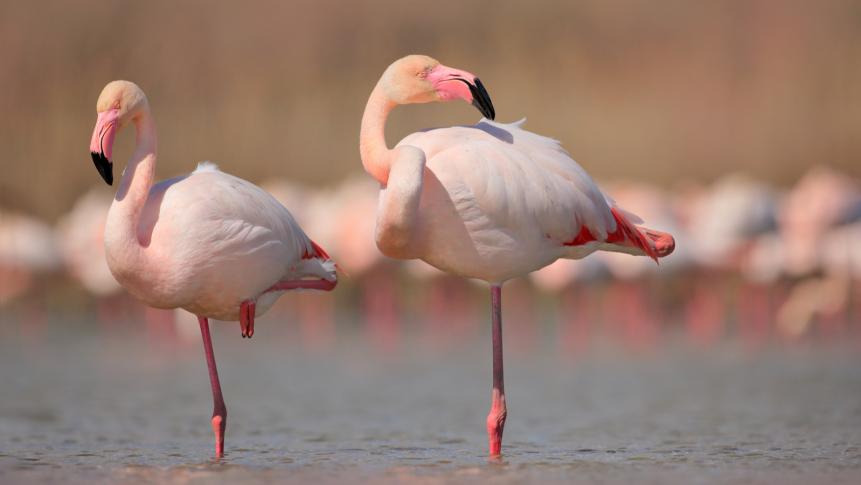
Shutterstock
The Real Reason Flamingos Stand on One Leg
It's hard to think of another bird as goofily charming as the flamingo. Penguins might have a fancier wardrobe, but flamingos have got an unflappable cool belied by their Pepto-Bismol color, their shoehorn-sized beaks, and their Slinky-like necks. Oh, and then there's their habit of standing around on one leg all the time. Why do they even do that?
Balance is for the Birds
There are a couple of ways to go about answering this question — you might try to answer why anyone individual flamingo stands on one leg, or why flamingos as a group developed this habit in the first place. There's recently been a major breakthrough on the first question, so we'll start there. But we're warning you: While no birds were hurt in this study, it's going to make you think about dead flamingos.
According to researchers Young-Hui Chang and Lena H. Ting, any given flamingo has a great reason to stand on one leg: It's just easier. You might be astonished by exactly how much easier it is, however. In videos of eight juvenile flamingos at Zoo Atlanta, they saw that not only did the birds easily fall asleep while standing on one leg but that when they were sleepy or restful, they would sway much less on that one leg than when they were awake on two. That suggests that flamingo joints have a "locked" resting position that secures them in place — as long as they're standing on one leg. But just to make sure, they wanted to prove that a flamingo could stand on one leg without any muscle activity whatsoever. And what better way to do that than by trying to balance deceased flamingos?
The grislier part of the experiment used two (previously) deceased flamingos from the Birmingham Zoo. Lo and behold, once the researchers were able to put the birds in the correct, one-legged position, they were able to stand up no problem. That's ... probably a bit further than we would have gone to prove a point, but at least we finally have an answer to the question, "Can dead flamingos stand up?" Yes. Yes, they can.

Shutterstock
Searching for a Theory With Legs
So there you go: Flamingos stand on one leg because it's physiologically easier for them to do so. The way their legs work means they can rest all of their weight on one side without having to use their muscles to maintain balance. Great. But why? What made the birds evolve this joint-locking trick? As with any speculation about the purposes behind evolution, we'll likely never know the complete answer. But there are a few theories on the broader reasons for the balancing act.
One theory, championed by animal behaviorist Matthew Anderson, is that the behavior helps the birds manage their heat regulation. According to his 2009 study, more flamingos start standing on one leg the colder it gets outside (although most flamingos prefer to stand on one leg most of the time anyway). That theory has gained some traction in recent years, but studies since that one have not been able to recreate their findings. Instead, those scientists suggest that the birds are lifting one foot as they drift off to sleep. Like dolphins and some other animals, only one side of a flamingo's brain sleeps at a time, so perhaps the birds lift up a leg on only one side because it's on the resting side.
Of course, one leg or two, there's still the question of why the birds sleep standing up in the first place. Well, flamingos make themselves at home on some of the most toxic, caustic bodies of water in the world. The water they prefer is often flesh-strippingly alkaline, and the ground that surrounds the shores absorbs those harmful properties. The scaly skin on their legs is tough enough to handle it, but their softer flesh is a little more at risk. In other words, if you were going to curl up on that mud, you'd start feeling uncomfortable pretty quickly. But if you can sleep standing up, then everything is just gravy.
This article first appeared on Curiosity.com.


















